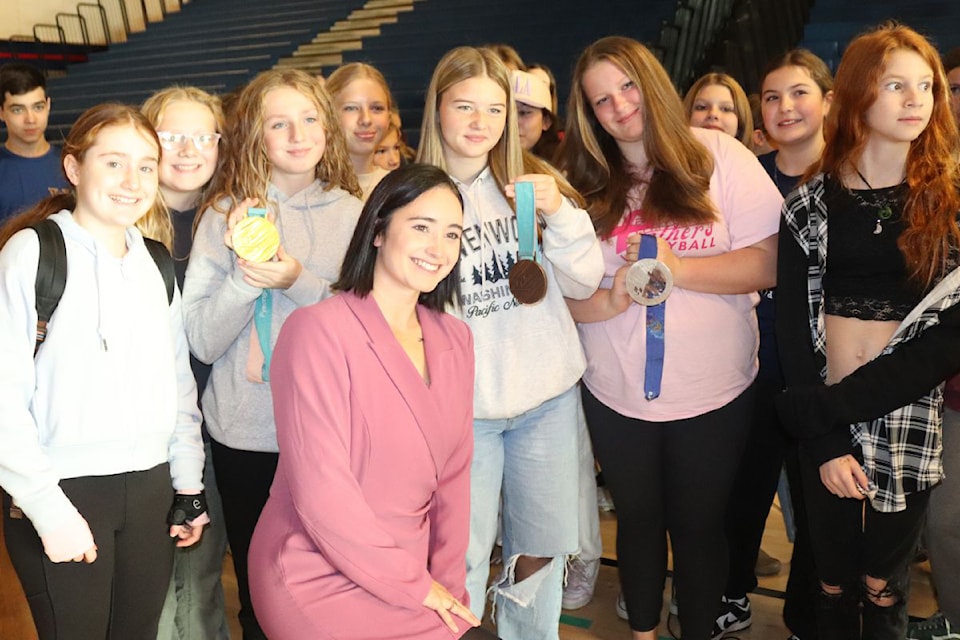It's a simple message to teenagers from a woman who's been in their shoes.
Stop working for perfection. Aim, instead, for excellence.
So says a woman who has set a fine example: three-time Canadian figure skating champion, three-time Olympic medallist (including gold) and 2018 World Women's Champion Kaetlyn Osmond. She shared her story of triumph and perseverance with Vernon Secondary School students Thursday, Oct. 10.
"Make mistakes, be good enough for you," said Osmond, 28, wrapping up her 30-minute presentation. "Be bad at something. I'm awful at golf but I keep playing. And find your support team. Friends, family, even teachers, anyone you want to be there when times are bad."
Osmond grew up in the same hometown as VSS principal Lynn Decker – Marystown, Nfld., and Labrador, about 300 kilometres west of St. John's. She told the students she began skating at two, and competed in her first national championship at age 10. At those nationals, she said, she was told, "don't expect anything because you're from Newfoundland and nobody is expecting anything from you."
Four years later, she went by herself to her first international competition in Japan, and that's where she sensed she wasn't good enough to belong with the other skaters, despite placing ninth overall.
"There were girls there older than me and they were doing tricks I'd never even heard of, let alone seen," said Osmond. "That's when I admitted to myself that I don't belong here, that I wasn't good enough."
As people are generally their own worst critics, Osmond's feelings of not being good enough for the world stage were re-interated by, of all people, the Canadian judge at the event. The judge said Osmond, the girl from Canada, "really sucked."
Osmond took the words to heart. She found out, she said, why the judge and others thought she was terrible. They didn't accept her for who she was.
They didn't care about results or placements, said Osmond, who was taller than the rest of the skaters and looked more mature than she was. Osmond wasn't doing tricks the judges wanted, like massive triple jumps.
"Because I didn't fit their mould, I was not on their trajectory," she said.
That changed when Osmond decided to work on her weaknesses, not her strengths.
She began fixating on the jumps and would later became the best female figure skating jumper in the world. But not before she started falling a lot and making costly errors in competition. Osmond was devastated to the point the things that she hated about skating were making her miserable, and she contemplated quitting the sport.
Her coach sat her down at nationals.
"We watched the older skaters skate and he said to me, 'you're not aiming to compete against these people, you're meant to compete against the best in the world,'" said Osmond. "He saw potential in me, and thought I could compete against world-class skaters."
She turned senior and was competing against skaters 10 years older. She came into the national championships that year and competed on TV for the first time. Osmond didn't win nationals then, but she did become the first woman in Canada to land a triple-triple jump combination.
Still, there was this drive for perfection.
Osmond was tired of making mistakes. A lot of mistakes, she said. She went to the national competition, won the title, yet felt angry. Mad that she felt she hadn't performed well enough to win that medal.
She made only one error.
So she hired a sports psychologist to deal with her negativity. Osmond called it the best decision she ever made.
"You don't need to be perfect 100 per cent of your life, but I wanted to feel excited about something," said Osmond to the student body. "The psychologist asked me, 'why do you have to be perfect?' Allow yourself to make that one mistake. Aim for excellence instead of perfection."
In 2017, when Osmond received her scores at the World Championships, she smiled. She had come in second. She said to the students coming in second was more fun than winning the World Championship, which she did a year later. Osmond became the first Canadian woman in 45 years since North Vancouver's Karen Magnusson in 1973 to win a World Figure Skating crown. And in doing so, she made one of the biggest gaffes of her career which can be found and watched daily, repeatedly, on YouTube.
"When I won the World title, I skated great and was doing a victory lap I launched myself over the carpet and somersaulted into my Canadian flag," chuckled Osmond, the image showing behind her on a projection screen to the audience. "I looked like a Canadian burrito."
Mistakes like that are fine, she said. You're allowed to laugh at yourself, make fun of yourself.
Osmond asked the students to give up perfection. It doesn't exist, she said.
"You're not going to get 100 per cent on every test," said Osmond. "Every day is not going to be amazing. You can only do what you can. Putting too much stress on yourself is only going to make it harder.
"Aim for excellence. Stop aiming for perfection. Allow yourself to make mistakes."
Osmond will return to the ice in December as part of a touring skating show.
She was appointed to the Order of Newfoundland and Labrador, her home province's highest individual honour, in 2019.




